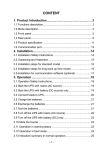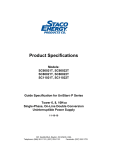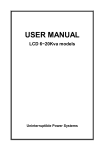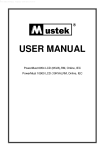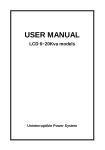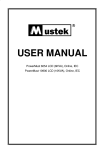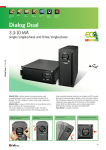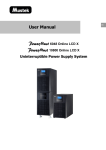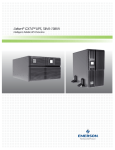Download Mustek PowerMust 3000 On Line(3K) User manual
Transcript
USER MANUAL ONLINE UPS PowerMust 1000E Online LCD (1K) PowerMust 2000E Online LCD (2K) PowerMust 3000E Online LCD (3K) PowerMust 6000E Online LCD (6K) PowerMust 10000E Online LCD (10K) Thanks for your purchasing this product! Safety instruction Please read carefully the safety instructions before you do anything to this product! CONTENT 1. Product introduction......................................................................... 1 1.1 Functions description .................................................................... 1 1.2 Mode description ........................................................................... 2 1.3 Description of commonly used symbols........................................ 3 1.4 Front panel .................................................................................... 4 1.5 Rear panel ..................................................................................... 9 1.6 Product specification ................................................................... 12 1.7 Communication port .................................................................... 16 2. Installation........................................................................................ 17 2.1 Installation Safety Instructions .................................................... 17 2.2 Unpacking and Inspection ........................................................... 18 2.3 Installation steps for 1-3K standard model.................................. 19 2.4 Installation steps for 1-3K long back up time model ................... 19 2.5 Installation steps for 6-10K.......................................................... 20 2.6 Installation for communication software (optional)...................... 23 3.Operation........................................................................................... 24 3.1 Operation Safety Instructions...................................................... 24 3.2 Start the UPS with mains (AC source) ........................................ 25 3.3 Start the UPS with battery (DC source) only............................... 25 3.4 Connect loads to UPS ................................................................. 26 3.5 Charge the batteries.................................................................... 26 3.6 Discharge the batteries ............................................................... 27 3.7 Test the batteries ......................................................................... 27 3.8 Turn off the UPS with mains (AC source) ................................... 28 3.9 Turn off the UPS with battery (DC) only...................................... 28 3.10 Mute the buzzer......................................................................... 29 3.11 Operation in warning status....................................................... 29 3.12 Operation in fault mode............................................................. 29 3.13 Buzzer indication summary in normal mode............................. 30 4. Maintenance ..................................................................................... 31 4.1 Maintenance Safety Instructions ................................................. 31 4.2 Typical Trouble Shooting ............................................................. 33 4.3 Battery Maintenance ................................................................... 36 4.4 Contact the service center........................................................... 36 5.Transport and Storage ..................................................................... 37 1. Product introduction 1.1 Functions description ● This product is a true online double-conversion UPS (Uninterruptible Power Supply). It provides perfect protection for critical load such as computer system. It can eliminate almost all mains power disturbances. The input AC current can be corrected to a wave following the mains voltage, so it is a high power factor system. Through the PWM control technology, the output voltage can be a pure & stable sine wave AC voltage. ● When the mains input become abnormal, the controller will stop the AC/DC and start the DC/DC section immediately to make sure the DC/AC (inverter) section can continue to work. After the mains input comeback to normal range, the DC/DC will be stopped and the AC/DC works again. So the load is always power-supplied through inverter without any interrupt if the UPS is turned on. ● The UPS also provides an internal bypass way to make the load can be powered by mains input directly when the UPS is off or failed. ● The UPS have an internal charger for batteries, the charger will charge the batteries when the mains is in a reasonable range on “bypass mode” or “line mode”. 1 1.2 Mode description ● Bypass mode Bypass mode means that the UPS provides the power through the internal bypass way to load directly without any regulation. If the controller detects the mains is abnormal, it will shut off the output to protect the load. The bypass voltage/frequency range and default output status (on/off) could be set by communication software. ● Line mode Line mode means that the mains input is rectified/converted by the AC/DC section and then inverted to stable output by DC/AC section. In line mode, the output is clean and good to the loads. If the mains get abnormal, the UPS will transfer to battery mode without interrupt. ● Battery mode Battery mode means that the battery power goes through the DC/DC section to the inverter (DC/AC) and get a stable backup output when the mains input is not usable. If the mains input recovered, the UPS will transfer to line mode without interrupt. ● Battery test mode In this mode, the UPS will stop the AC/DC section and discharge the battery while mains input is normal. If the controller found the battery is error, it will transfer back to line mode immediately, and warning by display to see whether the battery needs to be replaced. The battery test mode could be trigged in line mode by pressing the button or by the communication command. ● Fault mode If the UPS generates some internal failure and have to stop its inverter, it will go into fault mode and alarm by display and buzzer. In fault mode, the loads have the risk of power loss because the output will come from the bypass after UPS fault. 2 1.3 Description of commonly used symbols Some or all of the following symbols may be used in this manual. It is advisable to familiarize yourself with them and understand their meaning: 3 1.4 Front panel 1.4.1 Front view 1K/1KS 2K/2KS/3K/3KS 4 6KS/10KS 6K/10K 5 1.4.2 LCD display (1) LCD icon description Icon Icon name Description Mains icon It indicates the input is connected with mains, and the input power is supplied from the mains. Battery It indicates the input is connected with battery, and the input power is supplied from the battery. Bypass It indicates the UPS is in bypass mode, the load current is directly from the utility power. Inverter It indicates that the load current is supplied from utility power or battery via the inverter. Fault It indicates the UPS is in Fault mode. Warning It indicates the UPS has some warnings. Data Normally it indicates voltage/frequency value, which are displayed alternately. If the UPS is in fault, it indicates the fault code. Battery level It indicates the battery capacity. Every grid represents the capacity of 25%. All the grids turned on indicate the battery is full. Load level It indicates the load level. Every grid represents the level of 25%. All the grids turned on indicate the load is in 100% level. 6 (2) LCD display in different mode LCD icon Bypass mode (output disable) ● ● Bypass mode (output enable) ● ● Line mode ● ● ● ● ● ● Battery mode ● Battery test mode ● ★ Fault mode ◇ ◇ ◇ ◇ Warning □ □ □ □ ● ● ●: Lightened constantly ★: Flashing ◇: Depended on the fault status □: Depended on the original display 1.4.3 Button There is only one button for ON/OFF/Mute function on this product. The controller can distinguish the command according to the operation time difference. (1) Button action description Button actions are distinguished with “short-press” and “long-press”. Please refer to the following tables for the detail. Button action type Definition Short-press Press the button more than 0.04s and less than 0.5s Long-press Press the button more than 2s Invalid press Press the button more than 0.5s and less than 2s. 7 (2) UPS response to the button Original Button mode action Long-press Power off UPS response Turn on the UPS into battery mode. The internal power supply is trigged for a short time (cold status) Other press Bypass Long-press Turn on the UPS into line mode. mode Short-press Mute the buzzer if there is a warning or alarming. Long-press Turn into bypass mode. Short-press Turn into battery test mode. Battery Long-press Turn off the UPS. mode Short-press Mute the buzzer. Battery test Long-press Turn into bypass mode. mode Short-press Turn into line mode. Line mode Long-press Fault mode Short-press and then shutdown. Turn into bypass mode or shutdown, dependent on the fault type. Change the beep status of buzzer. 8 1.5 Rear panel 1K 1KS 2K 2KS 9 3K 3KS ①/② Communication port (USB or RS232) ③ Mains input protection ④ Mains input power cord ⑤ Output socket ⑥ External battery terminal block 10 ①/② Communication port (USB or RS232) ③ Mains input protection ④ AC input / output / External battery terminal block ⑤ Kickstand 11 1.6 Product specification 1.6.1 Model description This manual is applicable to the following models: Model name 1K 1KS 2K 2KS 3K 3KS 6K 6KS 10K 10KS Power 1000VA/700W 2000VA/1400W 3000VA/2100W 6000VA/4200W 10000VA/7000W rating Note: The model names without “S” represent standard model with internal battery. The model names with “S” represent long backup time model with external battery. 1.6.2 Environment specification Model 1K 1KS 2K 2KS 3K 3KS 6K 6KS 10K 10KS Operating 0-40°C Temperature Storage 0-40°C Temperature <1000m @ full load <2000m @ 90%load Altitude <3000m @ 80%load <4000m @ 70%load Relative <95% Humidity <50dB @ 1 meter from front <55dB @ 1 meter from front panel panel Noise Level 12 1.6.3 Mechanical Specification 1-3K Model 1K Dimension ((W×H×D) (mm) Weight (Kg) 1KS 144x220x345 9.8 5.2 2K 2KS 190x318x369 20 10.8 3K 3KS 190x318x369 24.6 10.8 6-10K Model Dimension 6K 6KS 10K 10KS 200x735x 509 200x376x 509 200x735x 509 200x376x 509 (W×H×D) (mm) Weight (Kg) 62 26 71 26 1.6.4 Electrical Specification Model 1K Power 1000VA/ 700W 1KS 2K 2KS 2000VA/ 1400W 3K 3KS 3000VA/ 2100W 6K 6KS 10K 10KS 6000VA / 4200W 10000VA / 7000W Input Current (Max.) 5A 6A 10A 11A 15A 16A 30A 32A 47A Voltage Range 176~276VAC @ full load (110~276VAC @ half load) Frequency Range 46 ~ 54Hz @ 50Hz system / 56 ~ 64Hz @ 60Hz system Input Power Factor ≧0.98 @ full load Output Voltage 208/220/230/240VAC (sine-wave) Synchronizing mains input @ line mode Frequency 50/60Hz ± 0.2 Hz @ battery mode 13 50A THD ≦4% ( Linear load ) Voltage Regulation ± 2% Overload Line mode: 60s @ 100%~130%; 1s @ > 130% Capacity Battery mode: 10s @ 100%~130%; 1s @ >130% Efficiency Line Mode 86% Battery Mode 80% 89% 83% 83% 24 48 72 VDC VDC VDC 84% 89% 88% 89% Battery & Charger @ 25℃ Total battery rating voltage 144 240 192 240 VDC VDC VDC VDC Backup Time >9min >9min >9min >9min >8min 5 5 5 5 5 Hours Hours Hours Hours Hours (Half Load) Recharge Time (to 90%) Charging Current 1A 4A 1A 4A 1A 4A 1A 4A 1A 4A (Max.) Discharging 44A 42A 42A Rated Charging 27.3 54.6 81.9 Voltage Vdc Vdc Vdc 24A 39A Current (Max.) 14 163.8 273 218.4 273 Vdc Vdc Vdc Vdc 1.6.5 Standards 1-3K * Safety IEC/EN 62040-1-1 * EMI Conducted Emission.......................................:IEC/EN 62040-2 Category C1 Radiated Emission......................................... :IEC/EN 62040-2 Category C1 Harmonic Current............................ :IEC/EN 61000-3-2 (Input Current≤16A) Voltage Fluctuation and Flicker........ :IEC/EN 61000-3-3 (Input Current≤16A) *EMS ESD............................................................. :IEC/EN 61000-4-2 Level 4 RS............................................................... :IEC/EN 61000-4-3 Level 3 EFT.............................................................. :IEC/EN 61000-4-4 Level 4 SURGE....................................................... :IEC/EN 61000-4-5 Level 4 CS............................................................... :IEC/EN 61000-4-6 Level 3 Power-frequency Magnetic field.................. :IEC/EN 61000-4-8 Level 3 Low Frequency Signals............................. :IEC/EN 61000-2-2 6-10K * Safety IEC/EN 62040-1-1 * EMI Conducted Emission....................................:IEC/EN 62040-2 Radiated Emission.......................................:IEC/EN 62040-2 Category C3 Category C3 *EMS ESD......................................................... :IEC/EN 61000-4-2 RS............................................................ :IEC/EN 61000-4-3 EFT.......................................................... :IEC/EN 61000-4-4 Level 4 Level 3 Level 4 SURGE.................................................... :IEC/EN 61000-4-5 CS............................................................ :IEC/EN 61000-4-6 Power-frequency Magnetic field.............. :IEC/EN 61000-4-8 Low Frequency Signals.......................... :IEC/EN 61000-2-2 Level 4 Level 3 Level 3 Warning: This is a product for commercial and industrial application in the second environment-installation restrictions or additional measures may be needed to prevent disturbances. 15 1.7 Communication port The communication port is for the monitoring software. There are 2 options: RS232 or USB. There is only one option can work in the same time and same product. 1) RS232 (optional) Pin assignment and description of DB-9 connector: Pin# Definition 2 TXD (output) 3 RXD (input) 5 GND 2) USB (optional) The USB port is compliance with USB 1.1 protocol for its communication software. 16 2. Installation 2.1 Installation Safety Instructions You must read the following safety instructions before installation! ● Installation Personnel This product must be installed only by qualified or professional personnel accord to safety ● Installation Environment Do not install and operate the UPS when water condensation happen which may occur if the UPS is moved directly from a cold to a warm environment. The UPS must be absolutely dry before being installed and operated. Please allow an acclimatization time of at least 2 hours. Otherwise there is hazard of electric shock! Do not install the UPS in the environment where it is damp or would be exposed to direct sunlight or near heat. Ensure the UPS is far away from water, inflammable gas and corrosive agents. Do not block air vents in the housing of UPS. The UPS must be installed in a location with good ventilation. Ensure enough space on each side for ventilation. 17 ● Wiring & Grounding Installation and Wiring must be performed in accordance with the local electrical laws and regulations. The UPS must be securely grounded. If there are external UPS battery cabinets, please make sure the battery cabinets have the equipotential earth bonding to the UPS main cabinet. An appropriate switch device as backup protection for over-current or short-circuit should be provided in the input utility. ● Battery Strictly follow the principle of “same voltage, same type” when paralleling multi battery packs. DC breaker or fuse must be used as a protection device between the external battery pack and the UPS. The spec of protection must be matched to the UPS specification. 2.2 Unpacking and Inspection 2.2.1 Unpack the package and check the contents. The shipped package contains: ● 1 UPS ● 1 user manual 2.2.2 Inspect the appearance of the UPS to see if there is any damage during transportation. Do not turn on the unit and notify the dealer immediately if there is any damage or lack of some parts. 18 2.3 Installation steps for 1-3K standard model 1) Make sure the wire / circuit breaker / socket are enough for the current rating of UPS to avoid the hazards of electric shock and fire. 2) Make sure the mains switch in the building is cut off. 3) Make sure the UPS is not be turned on before wiring operation. 4) Turn off all load switches first before connecting the load to the UPS. 5) Make sure the protective earth ground is correct. 6) Connect the loads to the UPS through the outlet sockets. 7) Connect the input power cord of UPS to mains. 2.4 Installation steps for 1-3K long back up time model 1) Make sure the wire / circuit breaker / socket are enough for the power rating of UPS to avoid the hazards of electric shock and fire. 2) Make sure the mains switch in the building is cut off. 3) Turn off all load switches first before connecting the load to the UPS. 4) Make sure the protective earth ground is correct. 5) Install the external battery as following: ● Warning: Make sure the mains input have been cut off. ● Switch off the battery breaker if there is a battery breaker. ● Remove the cover of external battery terminal of UPS. ● Warning: Pay highly attention to the rating battery voltage marked on the rear panel, the connection with wrong battery voltage may cause permanent damage of the UPS. ● Warning: Pay highly attention to the polarity marking on external battery terminal block, and make sure the correct battery polarity is connected. Wrong connection may cause permanent damage of the UPS. 19 ● Prepare the external battery cable that should be able to carry the current of >50A, the cross section area should be greater than 5.26 mm 2. It is recommended to use 8 AWG wire or thicker for safety and efficiency. And battery wire color is recommended as following: + GND - Red wire Yellow/Green wire Black wire ● Connect the GND pole of external battery terminal block on the rear panel of UPS to the earth point of battery pack. Note: Always connect the earth wire first! ● Connect the Positive (+) pole of external battery terminal block on the rear panel of UPS to the Positive polarity of battery pack; ● Connect the Negative (-) pole of external battery terminal block on the rear panel of UPS to the Negative polarity of battery pack. ● Check the wiring and voltage of the battery pack. Make sure the polarity and voltage is correct. ● Install the terminal block cover on the rear panel of the UPS. 6) Connect the loads to the UPS through the outlet sockets. 7) Connect the input power cord of UPS to mains. 2.5 Installation steps for 6-10K 1) Make sure the mains wire & breakers in the building are enough for the rating of UPS to avoid the hazards of electric shock and fire. Note: Do not use the wall receptacle as the input power source for the UPS, as its rated current is less than the UPS’s maximum input current. Otherwise the receptacle may be burned and destroyed. 2) Cut off the mains switch in the building before installation. 3) Turn off all the load switches before connect the load to the UPS. 20 4) Prepare wires according to the following table: Wiring spec (AWG) Model Input Output 6K 12 12 6KS 12 12 10K 9 9 10KS 9 9 Battery Ground 12 12 12 9 9 9 Note 1: The cable for 6K/6KS should be able to carry the current of >40A, the cross section area should be greater than 3.31 mm 2. It is recommended to use 12 AWG wire or thicker for safety and efficiency. Note 2: The cable for 10K/10KS should be able to carry the current of >60A, the cross section area should be greater than 6.63 mm 2. It is recommended to use 9 AWG wire or thicker for safety and efficiency. Note 3: The color of wires should be selected according to the local electrical laws and regulations. 5) Remove the terminal block cover on the rear panel of UPS. Then connect the wires according to the following terminal block diagram: (Always connect the earth wire first!) Wiring connection on the 6K/10K rear panel 21 Wiring connection on the 6KS/10KS rear panel Warning: (Only for standard model) ● Make sure the UPS is not turned on before installation. The UPS must not be turned on when doing wiring operation. ● Do not try to modify the standard model to the long back up time model. Especially do not try to connect the standard internal battery to the external battery. The battery type and voltage may be different. If you connect them together, it maybe causes the hazard of electric shock or fire! The standard model and long back up time model are differently designed according to different battery voltage and thermal solution. Warning: (Only for long back up time model) ● Make sure a DC breaker or other protection device between UPS and external battery pack is installed. If not, please install it carefully. Switch off the battery breaker before installation. ● Pay highly attention to the rating battery voltage marked on the rear panel, the connection with wrong battery voltage may cause permanent damage of the UPS. Make sure the voltage of the battery pack is correct. ● Pay highly attention to the polarity marking on external battery terminal block, and make sure the correct battery polarity is 22 connected. Wrong connection may cause permanent damage of the UPS. ● Make sure the battery input wiring is correct before power on. The wire current spec, color, position, connection and conductance reliability should be checked carefully. Make sure the +/- polarity is correct, not reverse, no short circuit. ● Make sure the protective earth ground wiring is correct. The wire current spec, color, position, connection and conductance reliability should be checked carefully. Make sure the mains input & output wiring is correct. The wire current spec, color, position, connection and conductance reliability should be checked carefully. Make sure the L/N site is correct, not reverse, no short circuit. ● Install the terminal block cover on the rear panel of the UPS ● 2.6 Installation for communication software (optional) 1) Connect the communication cable between UPS and PC. If the port is RS232, please lock the secure screw both on UPS and PC after connection. If the port is USB, it has Plug and Play function. 2) Please refer to the guide manual of software or contact the service center for installation and operation of management (monitoring) software. 23 3.Operation 3.1 Operation Safety Instructions You must read the following safety instructions before operation! ● operation personnel Laymen can operate this product. ● operation warning Do not disconnect the earth conducting wire on the UPS or the building wiring terminals in any time since this would cancel the protective earth of the UPS system and all connected loads. Do not try to disassemble the original part of the UPS before turn off and disconnect it from the mains power & external battery. The UPS output socket may be electrically lived even if the UPS system is not connected to the mains power source. Do not make any liquid and foreign objects enter the UPS. Turn off the mains input switch and external battery switch immediately at any accident of electric shock and fire related to the UPS. 24 3.2 Start the UPS with mains (AC source) 1) If the UPS is a long back up time model, with external battery banks, please switch on the battery breaker first; 2) If the wiring is correct, turn on the mains breaker in your building. Then the power supply inside the UPS will be started automatically, the fans will run, and the panel will display with bypass mode. Note 1: If the UPS have been set to enable the bypass output, the output socket will have the voltage directly from mains after you turn on the input breaker. Note 2: In bypass mode, the load is not protected by UPS. You should go on to the next step to turn on the UPS for protecting your load. 3) Press the button on the front panel of the UPS continuously for more than 2 seconds. The buzzer will beep once. After a few seconds of self-diagnoses, the UPS will be turned on to the normal mode (line mode) and output the spec voltage. 4) After the UPS is turned on to line mode normally, the panel will display line mode, and there is no beep of buzzer. Note: If the UPS is shutdown in battery mode automatically, and when the mains power returned to the input, the UPS will start up and switch to line mode automatically. 3.3 Start the UPS with battery (DC source) only This UPS can be started with DC source (battery) without AC source. 1) If the UPS is a long back up time model with external battery banks, please switch on the battery breaker first. 2) Press the button on the front panel of the UPS continuously for more than 2 seconds. The buzzer will beep once. After a few seconds of self-diagnoses, the UPS will be turned on to the battery mode and output the spec voltage. 25 3) After the UPS is turned on to battery mode normally, the panel will display battery mode, and the buzzer will beep according to the battery level. 3.4 Connect loads to UPS After the UPS is turned on, you can switch on the loads. 1) It is recommended to switch on the load one by one. The panel will display the load level. 2) If it is necessary to connect the inductance load such as a printer to the UPS, the start-up power should be considered for calculating the capacity of the UPS, because the power consumption is too big when this kind of load is started. 3) If the UPS is overloaded, all the load level grids indicator will flash and the warning indicator will lighten constantly. The buzzer will beep twice every second for alarming. 4) If the UPS is overloaded, some loads must be switched off or decreased immediately. It is recommend that the total loads connected to the UPS had better be less than 80% of its nominal power capacity to prevent the overload happen at the transient time, and it will make your system more safe. 5) If the overload time is over spec in line mode, the UPS will transfer to bypass, after the overload disappears, it will return to line mode. If the overload time is over spec in battery mode, the UPS will cut off the output and then shutdown according to the battery level. 3.5 Charge the batteries 1) After the UPS is connected to normal mains, the charger will work and charge the batteries automatically in bypass mode or line mode. 2) Suggest charging the batteries for 10 hours before use. Otherwise the backup time may be less than the standard value. 26 3.6 Discharge the batteries 1) When the UPS is in battery mode, the buzzer will beep according to different battery level. If the battery level is normal, the buzzer will beep once every 4 seconds; If the battery voltage drops to the alarming level, the buzzer will beep hurry (once every sec) to remind the user that the battery is low level and the UPS will be shutdown automatically soon. The user could switch off some non-critical loads to avoid the shutdown alarming and prolong the backup time. If have no more load to be switched off at that time, you have to shutdown all loads as soon as possible to protect the loads or save data. Otherwise there is the risk of data loss or load failure. 2) In battery mode if the user don’t like the buzzer noise, the beep could be muted by short-press the button. 3) The backup time of the long backup time model is dependent on the external battery capacity except the load capacity mainly. 4) The backup time may vary from different environment temperature and load type. 3.7 Test the batteries 1) If you need to check the battery level or aging status when the UPS is running on normal mode (line mode), you could short-press the button to let the UPS transfer to battery test mode. 2) To make the system more reliable, the UPS will perform the battery test automatically periodically. The default period is once per week. 3) The battery test could be performed by the command from monitoring software through the communication port. 4) If the UPS enter the battery test mode, the display and buzzer indication will be the same as the battery mode except that the Battery icon is flashing and the mains icon lighten constantly. So you can check the battery level at this mode. 27 3.8 Turn off the UPS with mains (AC source) 1) Firstly turn off the UPS (inverter) to bypass mode, please press the button continuously for more than 2 seconds. 2) After you press the button, the buzzer will beep once. Then the panel will display bypass mode. Note 1: If the UPS have been set to enable the bypass output, the output socket will have voltage from mains directly after you turn off the UPS (inverter) to bypass mode. Note 2: Because there is risk of power loss for the loads if you turn off the UPS to bypass mode, please make sure the loads are prepared for your operation. 3) If you want to turn off the output of UPS and shut down the UPS completely, you have to cut off the mains input of UPS. Note: please make sure all the loads are prepared or turned off for your operation before you shutdown the UPS system. 4) After you cut off the mains input of UPS to shut down, the background lighting is still on but all the icons are turned off to indicate that the UPS is saving data to the memory. After the saving process, the UPS will be shutdown completely. 3.9 Turn off the UPS with battery (DC) only 1) To turn off the UPS in battery mode, please press the button continuously for more than 2 seconds. 2) After you press the button, the buzzer will beep once, the background lighting is still on but all the icons are turned off to indicate that the UPS is saving data to the memory. After the saving process, the UPS will be shutdown completely. Note: please make sure all the loads are prepared or turned off for your operation before you shutdown the UPS system. 28 3.10 Mute the buzzer 1) To mute the buzzer, please short-press the button. If you short-press it again after the buzzer muted, the beep will be returned. 2) It is not anytime the buzzer can be muted. If it is in warning/batterylow/overload, the buzzer can’t be muted unless the trouble is solved. 3) If it is in fault mode, short-press the button could transfer the continuous beep to once-every-second. 3.11 Operation in warning status 1) In case the LCD background lighting is flashing once every 4 seconds, and the buzzer is beeping once every second, it shows that there are some troubles, please check the troubleshooting table in chapter 4 to find out what happen to the UPS. At this time, the warning indicator will be turned on constantly, the user can short-press the button to stop the background lighting flashing and turn on it for 1minute to see the warning status. 2) If the warning happens, the UPS will continue work in the original mode, the operation will not be interrupted. If the error is corrected, the warning alarm will stop. 3.12 Operation in fault mode 1) In case the LCD background lighting is flashing once every second and the buzzer is beeping continuously, it shows that there must be a fatal error in the UPS and it is operating in abnormal mode. At this time, the Fault indicator will be turned on constantly with the fault code displaying in the data section .The user can short-press the button to stop the background lighting flashing and turn on it for 1minute to see the fault code. 2) If fault happens, please notes and record what the display shows, the display information is very important for the trouble shooting. Please refer to the trouble shooting table in chapter 4 for detail. 3) Please check your loads, wiring, ventilation, mains, battery and so on after the fault happens. Don’t try to turn on the UPS again before find out the reason. If the trouble can’t be shoot, please contact the distributor or service people. 29 4) In the emergency case, please cut off the connection from mains / external battery / output immediately to avoid more risk or danger. 3.13 Buzzer indication summary in normal mode Operating mode Line mode Bypass mode Battery mode / Battery test mode Load level Battery level Buzzer beep once 0~100% None >100% Every 0.5 sec 0~100% Every 2 min >100% Every 0.5 sec 0~100% 0~25% Every sec 0~100% 25%~100% Every 4 sec >100% Every 0.5 sec 30 4. Maintenance 4.1 Maintenance Safety Instructions You must read the following safety instructions before maintenance! ● Maintenance Personnel This product must be maintained only by qualified professional personnel accord to safety instructions! ● Risk of electric shock No matter the UPS is connected to the utility power or not, the output may have electricity. The parts (battery, capacitor) inside the unit may still have hazardous voltage after turning off the UPS. Make sure to disconnect the batteries before carrying out any kind of maintenance or repair. In this product, the battery is dangerous. Verify that no voltage between the battery terminals and the ground is present before maintenance or repair. In this product, the battery circuit is not isolated from the input voltage. Hazardous voltages may occur between the battery terminals and the ground. Verify that no hazardous voltage exists in the energy storage capacitor before maintenance or repair. 31


































